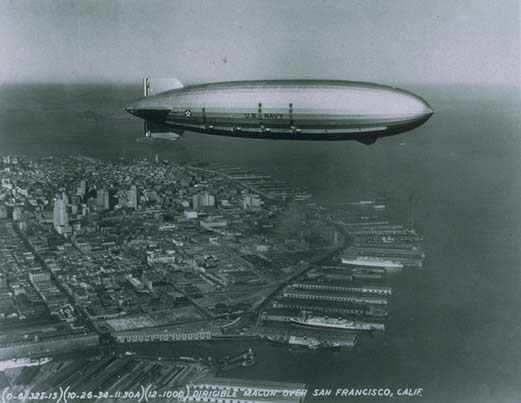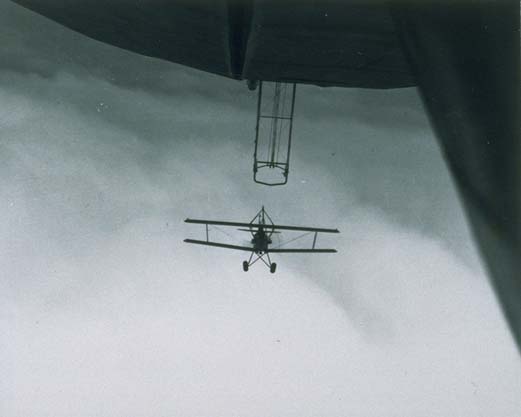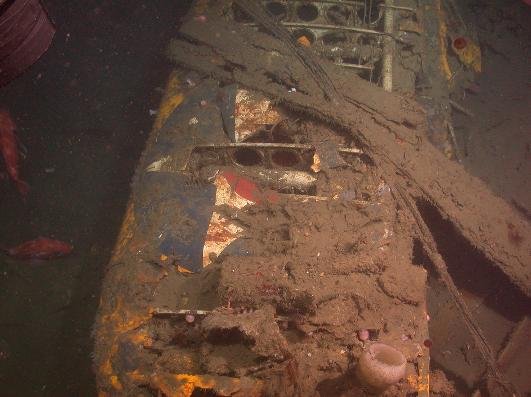Original URL: https://www.theregister.com/2010/02/12/macon_wreck_now_historic/
Wreck of 1930s flying aircraft carrier dubbed 'historic'
Captain Scarlet style dirigible Cloudbase honoured
Posted in Science, 12th February 2010 12:35 GMT
The US government has added the crash site of the most powerful flying aircraft carrier ever built to the National Register of Historic Places, 75 years after the event.

Fleet Week really meant something back then
The airship USS Macon - comparable in size to the even more famous and equally doomed liner Titanic - suffered storm damage and crashed into the ocean off Point Sur, south of San Francisco, exactly 75 years ago yesterday. The huge dirigible's remains and those of her embarked biplane fighters now lie 1500 feet below the waves in the Monterey Bay National Marine Sanctuary. However, all but two of the 83 men aboard survived the crash and were rescued by responding waterborne ships.
“The USS Macon and its associated Sparrowhawk biplanes are not only historically significant to our nation’s history, but have unique ties to our local communities, where public museums highlight the airship’s history,” said Paul Michel, Monterey Bay National Marine Sanctuary superintendent. “The National Register listing highlights the importance of protecting the wreck site and its artifacts for further understanding our past.”
The Macon and her sister ship Akron - also lost in a storm at sea two years previously - were unique even in the era of the great rigid airships in that they carried a force of fighter planes which could be launched and recovered in mid-air. A "trapeze" arm attached to a "skyhook" on the biplanes' upper wings swung the fighters out through a T-shaped door in the ship's belly. The airship was fast enough that the planes could match speeds with it in order to hook onto the trapeze again after a flight: there was no need for catapult launch, heavy arrester gear and jolting landings (or alternatively vertical-lift aircraft) as there is with ordinary seaborne aircraft carriers.
The Men on the Flying Trapeze
The ships were intended for long-duration operations over the Pacific Ocean, and during such cruises the Sparrowhawk fighters had their wheeled undercarriages taken off, relying solely on their skyhooks and achieving reduced drag and better performance. The hook-on manoeuvre was said to be a knack: once a pilot knew how to do it, it was easier than landing on a normal carrier. Certainly the pilots of the airship Heavier-Than-Air Units (aka "the men on the flying trapeze") had a far better safety record than their wet-navy counterparts, with a perfect recovery record.

Forget Battlestar Galactica, Captain Scarlet and those lads, this was the real deal
The flying aircraft carriers and other US military dirigibles enjoyed the privilege of inflating their lift cells with non-flammable helium, when other nations' ships had to use dangerous hydrogen. The USA at the time controlled almost the entire world supply of bulk helium, found in exploitable amounts in certain natural-gas fields in and around Texas. The US government later went on to establish a vast stockpile of the gas in a vast underground rock dome formation, which still exists today - though no longer primarily for use in airships.
The Macon was originally based at the Lakehurst naval air station in New Jersey - now the site of a protoype electromagnetic mass-driver catapult intended for ordinary aircraft carriers - but in 1933 she was transferred to the famous Moffett Field in Silicon Valley, today home to NASA's Ames facility.
She joined in exercises with the US Pacific fleet on several occasions, gradually learning how to deploy her aircraft in a scouting screen and get them back again afterward. It was often claimed that she had been "shot down" by aircraft of the opposing side; on other occasions the Macon's own fighters beat off such attacks.
Disaster off Point Sur
Opinion on the carrier airships' value was still divided when the Macon unmoored at Moffett for her last cruise on February 11, 1935. Earlier damage to her tail fin was still awaiting repair, but such was the pressure for the big ship to prove her value that this was postponed.

A Sparrowhawk wing photographed underwater at the crash site.
The next day, returning to base, the ship was hit by a storm off Point Sur. Violent crosswinds tore off the previously damaged dorsal fin, causing puctures to the aft gas cells. The tail dropped towards the ocean, and the Macon's captain ordered ballast, fuel and unessential items jettisoned.
The tail didn't strike, but the ship then surged up out of control to 5,000 feet before beginning her last descent. The impact with the sea was relatively gentle, and almost all the crew were able to abandon ship in good order with rafts and lifejackets.
The wreck of the Macon, the Akron before her and the non-carrier ship Shenandoah previously left the USA with just one rigid airship in service. Britain had previously abandoned such ships following the R101 disaster in 1930, and the US now followed suit - though the US Navy continued to operated non-rigid blimps with success through World War II and beyond. Germany stayed the course for a while, but just two years after the wreck of the Macon the Hindenburg went down in flames while landing at Lakehurst, and the day of the mighty rigid airships was over.
Not quite over, perhaps. Apart from ordinary blimps like the Goodyear ones there are still a few airships flying with a rigid structure in their gas envelopes - namely the Zeppelin "Neue Technologie" (NT) ships produced Luftschifftechnik GmbH of Friedrichshafen in Germany, the successor to Count von Zeppelin's original venture. The NT zepps, while nowhere near the size of their illustrious predecessors, have a partial internal structure of glass-reinforced plastic and aramid. This offers better stiffness and links the propulsion, steering and gondola together, making the NTs technically semi-rigids.
Eureka, an NT Zeppelin, is based at Moffett field offering tourist flights. NASA Ames boffins chartered her last year to look for "extremophile" alien-like life forms in the San Francisco area. ®